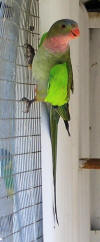. princess parrot

The Princess parrot is a member of the POLYTELIS genus along with the Regent and Superb parrot. Aviary Notes: Level Of Knowledge Required: Beginner / Intermediate / Advanced / Specialist Breeders Only. Government Regulations & By-Laws: Refer to " Government Laws " web page. Housing Requirements: Refer to " Housing Birds " web page for general details on the housing of Australian Parrots or read on for specific details for this parrot. Princess Parrots can be housed in a wide variety of sizes of aviaries. Although they are best bred as one pair per flight, they seem to breed better if they can see or hear another pair or pairs of Princess parrots. An aviary of 4 metres (12 feet) long is considered the minimum to adequately house these birds. Have been successfully bred as a colony of 3 - 5 pairs in a large aviary. Non-toxic leafy branches can be placed in the aviary for the birds to chew up. This will entertain the birds, help minimize boredom and give the birds some beak exercise. Natural branches of various diameters, and placed at various angles, can be used for perches. These natural perches may be chewed by the birds and may need to be replaced regularly. The birds may chew any flowers and fruiting bodies on the branches. Diet / Feeding: Refer to " Feeding Birds " web page for general details on the feeding of Australian Parrots or read on for specific details for this parrot. Princess Parrots require a quality Parrot mix and a variety of fruits such as apple and orange as well as a variety of vegetables - corn, silverbeet. Greenfoods and green leafy vegetables should be offered. Seeding grasses if available. Soaked or sprouted seed if available. Dry commercial pellet feeds are becoming available and may be part of a balanced diet. Some birds will consume insects such as mealworms, especially around breeding season. Insects will provide the adult birds and young with a good source of easily digestible protein. Insects can be fed to these birds on a daily basis. Nesting: A basic overview only. Dimensions are typical / average and can vary widely, influenced by the owner's preferences and the birds preferences. Parent bird's preferences can also be influenced by the size and type of nest-box / log in which the bird was hatched and reared. If space allows, offering a choice of sizes and types of logs or nest-boxes, and placed in various locations within the aviary, can allow the parent birds to make their own choice. Once a pair has chosen a specific nest-box/log and been successful in it, offer that one to them each breeding season. Try and keep that one for their exclusive use. Once a pair has chosen its log or nest-box, the other ones can generally be removed. If the "spare" boxes are to be removed and moved to another flight, ensure the log / nest box is cleaned to ensure the receptacle has the minimal contamination of mites, parasites and pathogens. All Australian parrots will breed in hollow logs.
Timber nest-boxes generally require a climbing structure attached inside the box below the entrance hole. Both logs and nests need an entrance hole/opening of about 65 - 75 mm diameter and about 100 mm (about 4 inches) from the top. Many species of parrots like the entrance hole to be just big enough to squeeze through. More details on parrot nestboxes/logs and a selection of parrot nestbox/log photos can be found on the "nests", "parrot nests" and "parrot nestbox photos" web pages. Click on "Up" then "Nests" then "parrot nests" and "parrot nestbox photos" in the navigation bars. Breeding: Egg Colour White. Clutch/s per year 2. Eggs per nest 4 - 6. Incubation approx. 20 days. Fledge approx 5 weeks. Independent approx. another 3 weeks. When breeding to produce a particular colour mutation, the placing of a closed metal leg ring on each young Princess parrot will be essential. This also applies if the pure "normal" coloured birds are being bred. If you have not placed a leg ring on a young bird, seek advice and instruction from an avian veterinarian or experienced breeder who leg rings their birds. Artificial incubation and hand rearing or fostering will not be covered on this web site. It is too complex and diverse in nature to be attempted here. Health Issues: Refer to "Avian Health Issues" web page for information and references.
General References: Refer to references listed on "Book References" web page. Specific References:
|